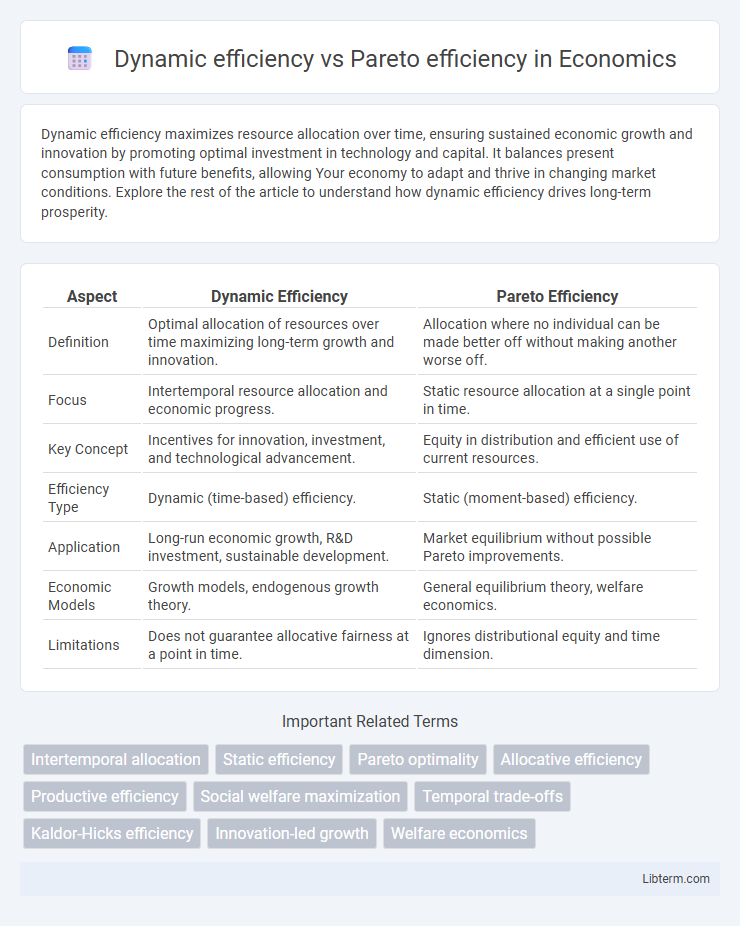Dynamic efficiency maximizes resource allocation over time, ensuring sustained economic growth and innovation by promoting optimal investment in technology and capital. It balances present consumption with future benefits, allowing Your economy to adapt and thrive in changing market conditions. Explore the rest of the article to understand how dynamic efficiency drives long-term prosperity.
Table of Comparison
| Aspect | Dynamic Efficiency | Pareto Efficiency |
|---|---|---|
| Definition | Optimal allocation of resources over time maximizing long-term growth and innovation. | Allocation where no individual can be made better off without making another worse off. |
| Focus | Intertemporal resource allocation and economic progress. | Static resource allocation at a single point in time. |
| Key Concept | Incentives for innovation, investment, and technological advancement. | Equity in distribution and efficient use of current resources. |
| Efficiency Type | Dynamic (time-based) efficiency. | Static (moment-based) efficiency. |
| Application | Long-run economic growth, R&D investment, sustainable development. | Market equilibrium without possible Pareto improvements. |
| Economic Models | Growth models, endogenous growth theory. | General equilibrium theory, welfare economics. |
| Limitations | Does not guarantee allocative fairness at a point in time. | Ignores distributional equity and time dimension. |
Understanding Economic Efficiency
Dynamic efficiency emphasizes optimal resource allocation over time, promoting innovation and long-term growth by balancing present consumption with future benefits. Pareto efficiency focuses on the static allocation of resources where no individual can be made better off without making someone else worse off, highlighting immediate optimal distribution. Understanding economic efficiency requires integrating both concepts to achieve sustainable development and equitable resource use.
What is Pareto Efficiency?
Pareto efficiency occurs when no individual can be made better off without making someone else worse off, representing an optimal allocation of resources in a static context. This concept emphasizes the distribution of resources where improvements for one party do not come at the expense of another's welfare. Unlike dynamic efficiency, which considers improvements over time and innovation, Pareto efficiency focuses solely on the immediate reallocation of existing resources.
Defining Dynamic Efficiency
Dynamic efficiency refers to the optimal allocation of resources over time, ensuring sustainable growth and innovation by balancing present consumption with future investment. It emphasizes intertemporal choices that maximize overall welfare across different periods, incorporating factors like technological progress and capital accumulation. This contrasts with Pareto efficiency, which assesses optimal resource allocation at a single point in time without considering temporal trade-offs or long-term impacts.
Key Differences Between Dynamic and Pareto Efficiency
Dynamic efficiency emphasizes optimal allocation of resources over time, considering innovation, technological progress, and long-term growth, while Pareto efficiency focuses on immediate resource allocation where no individual can be made better off without making another worse off. Dynamic efficiency accounts for future benefits and investment impacts, contrasting with Pareto efficiency's static assessment at a specific moment. The key difference lies in dynamic efficiency's forward-looking approach versus Pareto efficiency's snapshot of allocation without time considerations.
Examples of Pareto Efficiency in Markets
Pareto efficiency in markets occurs when resources are allocated in a way that no one can be made better off without making someone else worse off, exemplified by perfectly competitive markets where prices reflect both consumer preferences and producer costs. For instance, the equilibrium reached in stock markets often demonstrates Pareto efficiency because trades happen only when both buyers and sellers benefit, maximizing mutual gains without disadvantaging others. Dynamic efficiency, in contrast, evaluates how resource allocation evolves over time to encourage innovation and growth, which is less apparent in static examples like Pareto efficient market equilibria.
Real-World Applications of Dynamic Efficiency
Dynamic efficiency emphasizes optimal resource allocation over time, crucial in industries like technology and renewable energy where innovation and sustainable growth matter. Real-world applications include investment decisions in research and development, where future benefits outweigh immediate costs, and policies promoting green technologies to balance economic growth with environmental preservation. Unlike Pareto efficiency, which focuses on static allocation without improvements, dynamic efficiency drives long-term welfare by fostering technological progress and adaptable market conditions.
The Role of Innovation in Dynamic Efficiency
Dynamic efficiency emphasizes the importance of innovation and technological progress in driving long-term economic growth and improving resource allocation over time. Unlike Pareto efficiency, which focuses on optimal allocation at a specific moment without making anyone worse off, dynamic efficiency prioritizes investments in research and development, fostering new products and processes that enhance productivity. Innovation plays a crucial role by enabling economies to adapt, evolve, and expand their production possibilities frontier, resulting in sustained improvements in welfare beyond static resource distribution.
Limitations of Pareto Efficiency
Pareto efficiency fails to account for dynamic efficiency, as it overlooks the importance of resource allocation over time and innovation-driven growth. It assumes static conditions and does not consider how reallocating resources today might improve future productivity or welfare. This limitation restricts its application in long-term economic planning where dynamic efficiency promotes sustainable improvements.
Policy Implications: Choosing Between Dynamic and Pareto Efficiency
Policy implications of choosing between dynamic efficiency and Pareto efficiency hinge on balancing long-term innovation incentives with short-term resource allocations. Prioritizing dynamic efficiency promotes investment in technology and growth, often at the expense of immediate equitable outcomes emphasized by Pareto efficiency. Policymakers must design frameworks that integrate sustainable development goals with fair distribution to optimize both innovation-driven economic expansion and social welfare.
Striking a Balance: Achieving Optimal Economic Outcomes
Dynamic efficiency emphasizes innovation and long-term growth by allocating resources to projects with future benefits, while Pareto efficiency focuses on allocating resources in a way that no individual can be made better off without making someone else worse off. Striking a balance between the two requires policies that foster sustainable innovation without compromising current resource distribution equity. Optimal economic outcomes emerge when dynamic efficiency drives growth opportunities and Pareto efficiency ensures fairness and stability in resource allocation.
Dynamic efficiency Infographic

 libterm.com
libterm.com